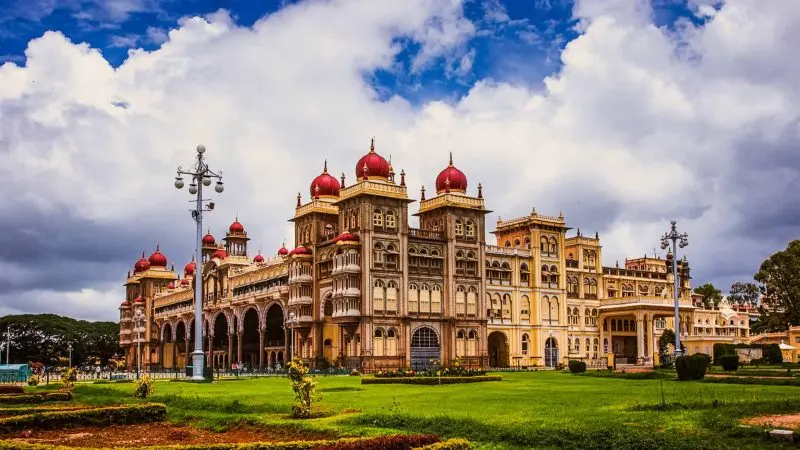Mysore Palace, also known as the Amba Vilas Palace, is a majestic architectural wonder nestled in the heart of Mysore city in the southern state of Karnataka, India. Admired for its opulent beauty and cultural significance, the palace stands as a testament to the rich history and heritage of the region.
This article explores the fascinating history of Mysore Palace, highlights the reasons why it is a must-visit destination, provides insights into its location and how to reach it, suggests the best time to plan a visit, and showcases the enchanting features that await visitors within its grand walls.
History
The history of Mysore Palace dates back to the 14th century when the original wooden structure stood at the site of the present-day palace. However, the palace as we see it today was commissioned by Maharaja Krishnaraja Wadiyar IV and completed in 1912.
The palace was designed by the British architect Henry Irwin, incorporating a harmonious fusion of Indo-Saracenic, Gothic, and Rajput architectural styles. The interiors of the palace were adorned with intricate carvings, paintings, stained glass, and a plethora of precious materials.
Why Visit Mysore Palace
1. Architectural Marvel
Mysore Palace is an architectural masterpiece that captivates visitors with its splendid domes, grand arches, ornate ceilings, and meticulously designed courtyards. The intricate craftsmanship and attention to detail throughout the palace are awe-inspiring.
2. Historical Significance
The palace stands as a symbol of the illustrious Wadiyar dynasty, which ruled Mysore for several centuries. It provides a glimpse into the opulent lifestyle of the royals and the rich history of the region.
3. Cultural Heritage
Mysore Palace is a repository of the region’s cultural heritage. It houses a remarkable collection of royal artifacts, including paintings, weapons, jewelry, costumes, and other regal memorabilia, which offer insights into the royal traditions and customs.
4. Illumination and Festivals
The palace illuminations during the Dasara festival are a sight to behold. Thousands of lights decorate the palace, creating a mesmerizing spectacle that attracts tourists from far and wide. The palace also hosts various cultural events and exhibitions throughout the year.
Location and Route
Mysore Palace is centrally located in the city of Mysore, in the southern part of the state of Karnataka, India. It is situated on Sayyaji Rao Road, approximately 150 kilometers southwest of the state capital, Bangalore. The palace is easily accessible by road, rail, and air.
Mysore has a well-connected railway station and an airport with regular domestic flight services. Several buses and taxis also operate from major cities in Karnataka to Mysore.
When to Visit
The best time to visit Mysore Palace is during the months of October to February when the weather is pleasant. The scorching summer months of April to June should be avoided.
Additionally, visiting during the festive season of Dasara, usually held in September or October, provides an opportunity to witness the grand celebrations and elaborate processions that add an extra touch of magic to the experience.
What to See
1. Durbar Hall
This grand ceremonial hall showcases the palace’s opulence, featuring an intricately carved ceiling, ornate pillars, and a magnificent golden throne. The hall offers a glimpse into the royal court proceedings and ceremonies.
2. Kalyana Mantapa
This spacious marriage hall is adorned with exquisite stained glass ceilings and elaborate floral motifs. It is a popular venue for cultural events and weddings.
3. Royal Armoury
Displaying a vast collection of weaponry, including swords, daggers, and firearms, the Royal Armoury offers a fascinating insight into the martial history of the region.
4. Ambavilasa
This elaborately decorated room serves as the private durbar of the royal family, adorned with colorful frescoes, intricately carved wooden doors, and an impressive silver door.
5. Palace Gardens
The palace is surrounded by beautifully manicured gardens that offer a serene ambiance for leisurely walks and picnics.
Conclusion
Mysore Palace is a treasure trove of history, culture, and architectural brilliance that should be on every traveler’s itinerary. Its magnificent structure, rich heritage, and the grandeur it exudes make it an unforgettable destination. The palace stands as a proud testament to the regal legacy of Mysore and continues to enthrall visitors with its splendor and charm.
A visit to Mysore Palace is a journey through time, allowing one to immerse themselves in the grandeur of an era long gone.
